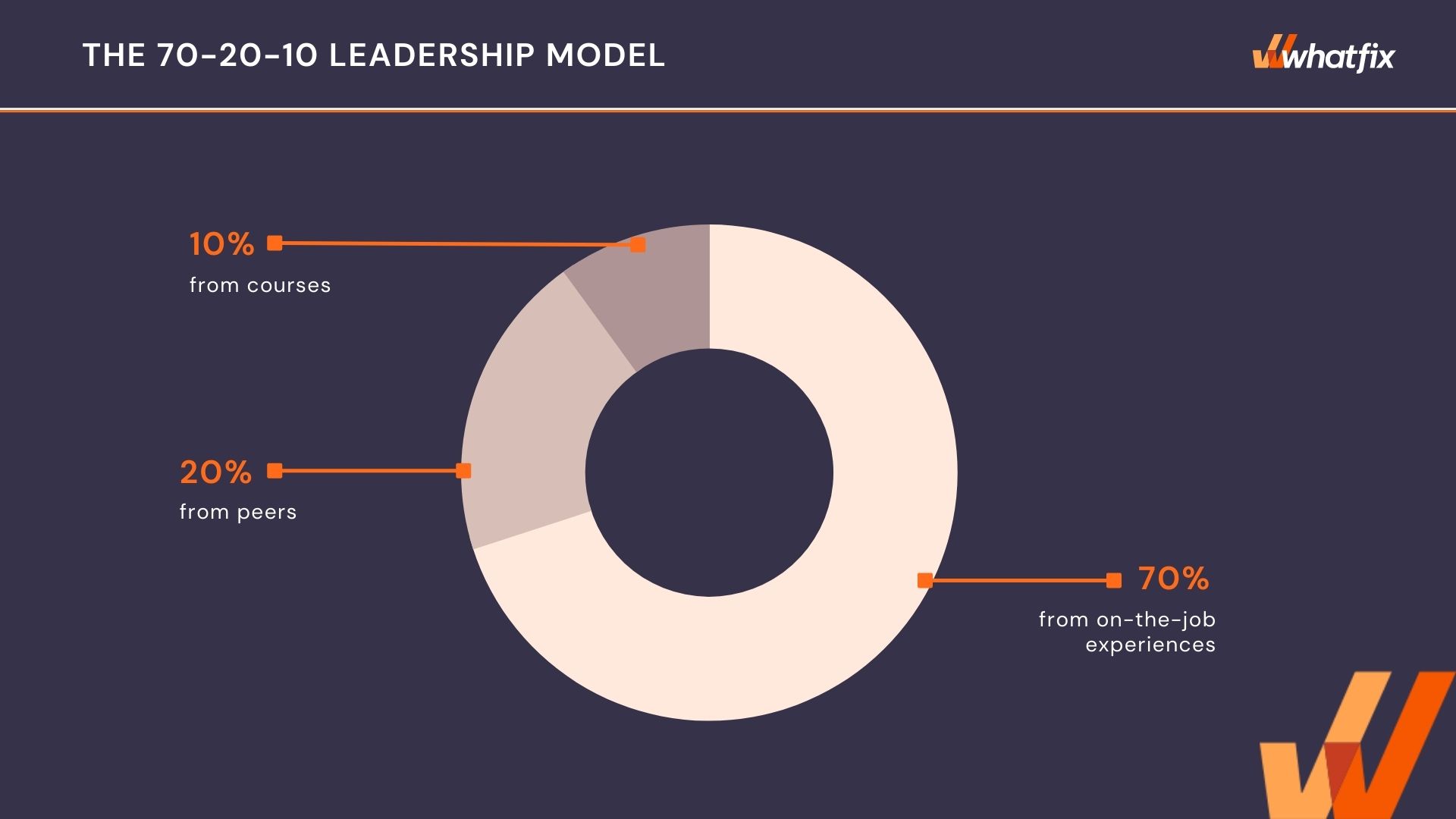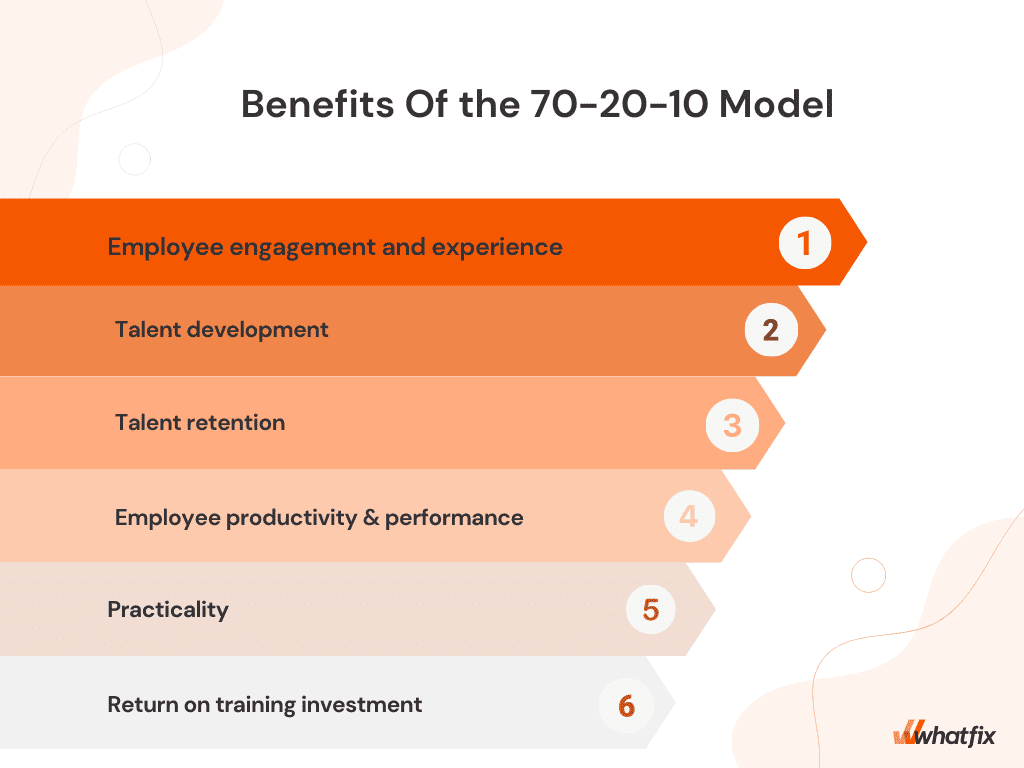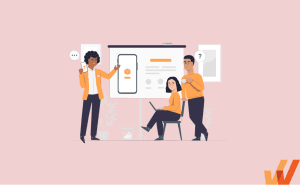The 70-20-10 Model for Corporate L&D (+Template)
- Updated: July 18, 2024


The 70-20-10 model is a well-known L&D framework created in the 1980s by three researchers (McCall, Lombardo, and Morrison). Their research surveyed 191 executives to recall pivotal career events and self-report how they acquired knowledge and skills.
It found that 70% of learning resulted from on-the-job experiences and hands-on learning, 20% from developmental relationships and social learning, and 10% from formal training and traditionally structured learning programs.
Since then, the 70-20-10 model has become one of the primary L&D strategies adopted by organizations to drive knowledge acquisition and skill development. Now, with popular digital workplace technologies like Whatfix, organizations can enable their employees to have hands-on IT training that provides in-app performance support on their digital workflows and tasks. This helps them learn while doing and drives knowledge retention, all while keeping employee productivity high.
What Is the 70-20-10 Learning Model?
The 70-20-10 model is a popular learning and development framework and reference model that states:
- 70% of learning should come from experiences employees face at work while completing their day-to-day tasks.
- 20% from informal social interactions and peer-to-peer learning.
- 10% from formal, traditional training sessions.
Organizations use this L&D framework to shift their focus from one-time, large-chunk training sessions and workshops to microlearning interactions embedded into their workflows, commonly referred to as learning in the flow of work. This enables employees with a more holistic, engaging, and effective approach to learning that doesn’t sacrifice employee output and productivity.

Formal vs Informal Learning
Formal and informal learning represent two different learning styles; both have merits, responsibilities, and individual roles to play in corporate L&D programs.
- Formal learning refers to more structured and organized types of training. Formal L&D typically involves traditional learning methods and mediums – like documented classroom-based curricula, courses, training programs, abd workshops. Formal learning is always designed with a specific learning outcome, often like onboarding a new hire, achieving accreditation, or obtaining a certification.
- Informal learning is not structured, is more spontaneous, and can be difficult to quantify. It occurs as a natural byproduct of work experience or interacting with peers. For the most part, informal learning does not have any designed plan or program, but its engaging, hands-on approach leads to improved job proficiency, better knowledge retention, and higher skill ceilings than formal training methods.
The 70-20-10 Model heavily emphasizes the importance of informal learning, suggesting 90% of learning should come from these sources (70% by learning in the flow of work and 20% from social learning). However, formal and informal learning are essential to training workforces and complement each other. L&D professionals should take a blended learning approach and incorporate both formal and informal training into their plans.
| Formal Learning | Informal Learning | |
| Approach |
|
|
| Methods and Mediums |
|
|
Breaking Down the 70-20-10 L&D Model
Let’s break down the 70-20-10 model to understand each stage’s impact, as well as examples for each.
70% of learning comes from on-the-job experiences
The majority of knowledge, 70%, is acquired through hands-on experience, daily tasks, and challenges. This is known as experiential learning.
Experiential learning happens through completing on-the-job tasks, resolving issues practically, and practicing tasks daily. This learning is informal, self-directed, and enables employees to learn from their experiences on the job, on a daily basis. This means no expensive and time-consuming classroom training seminars are required outside of employees’ work environment.
Experiential learning allows employees to explore and refine their job-based skills, make their own decisions, address challenges, learn from mistakes, and be open to performance feedback.
A few examples of experiential, on-the-job learning include:
- Day-to-day work experiences (ie. learning by doing).
- Auditing and peer reviews.
- Reflection.
- General problem solving and learning from one’s mistakes.
- Hands-on learning through in-app guidance and on-demand support (like tooltips, interactive walkthroughs, and in-app resource centers embedded into employee workflows).
20% of learning comes from informal training such as peers and social interactions
Learning doesn’t happen in isolation. Humans are social creatures who crave connectedness and find a way to inject social interaction into every aspect of their lives. This brings us to the second part of the 70-20-10 model – social learning.
Social learning is responsible for 20% of all knowledge intake. Social learning happens by interacting with and observing your peers, completing tasks or projects together, overcoming challenges as a team, and working towards a common goal.
Learning from others is also achieved in the form of mentoring and coaching. These methods of training involve an experienced professional – a supervisor, mentor, or veteran employee – who mentors or coaches an employee on specific job tasks and responsibilities.
Organizations need to create a learning culture within the workplace to support and facilitate social learning. Embracing a learning culture leads to a productive work environment culture where teams are willing to support and learn from each other.
An example of social learning could be a sales employee who wants to acquire better negotiation skills. The best way for them to learn is through a negotiating scenario with a peer or manager already adept at the skill.
A few examples of informal training that drive this 20% of learning include:
- Collaboration with peers on projects.
- Peer-to-peer learning.
- Cross-training programs.
- Formal and informal feedback,
- Learning from professional networks like LinkedIn and Slack communities.
10% of learning comes from formal training
Although it only constitutes 10% of learning, formal training is an essential part of any learning strategy. It forms the backbone of successful learning and development initiatives and improves employee performance by delivering goal-orientated training via face-to-face or online training.
Face-to-face training sessions are headed by a trainer who conducts tutorials, seminars, and workshops in a classroom-like setting. On the other hand, online learning is delivered through employee training software such as learning management systems or digital adoption platforms.
eLearning allows you to provide training in various formats, from SCORM xAPI-based courses to webinars and videos. Employees have the freedom to learn in their own time and pace. And the progress of every employee can be easily measured through training software.
A few examples and types of employee training that drive this 10% of learning include:
- Courses
- Modules
- Keynotes
- Workshops
- Seminars
Software clicks better with Whatfix's digital adoption platform
Enable your employees with in-app guidance, self-help support, process changes alerts, pop-ups for department announcements, and field validations to improve data accuracy.
Why Is the 70-20-10 Learning Model Effective?
Here are three reasons the 70-20-10 model is an effective learning and development framework for employees.
1. It takes a blended learning approach
With eLearning, you can blend the experiential learning part of the 70-20-10 model with formal learning. This creates a more blended learning experience for learners that takes a hybrid approach to learning and includes traditional training, eLearning, social learning, and on-the-job learning. This approach boosts engagement and helps employees better retain the information they’re presented with.
2. It's a contextual experience built for the learner
The 70-20-10 model gives employees a sense of autonomy. 70% of the 70-20-10 model constitutes on-the-job learning which provides them with the confidence to perform their tasks efficiently, see how their actions and decisions lead to positive or negative repercussions for the organization, and explore their cognitions and learn by doing rather than sitting on the sidelines.
3. It scales with your organization
The majority of learning opportunities through the 70-20-10 model are provided on the job and through social learning, making any learning and development program easy to scale without sacrificing personalization.

Benefits of the 70-20-10 Learning Framework
Here are some major benefits of the 70-20-10 model
1. Employee engagement and experience
Because the model puts less emphasis on formal training, the 70-20-10 learning solution allows for flexibility, helping employees refine their job-related skills and make decisions for their ongoing learning and development. On-the-job training approach makes learning actionable, keeping employees more active, dedicated, and engaged throughout the process.
2. Fosters talent development
Informal learning promotes collaboration, and new perspectives cultivate a knowledge-sharing culture that fosters talent development. Effective knowledge sharing improves team and individual productivity, empowers employees, and builds a strong, connected workforce.
3. Improves talent retention
Delivering continuous training programs through the 70-20-10 approach keeps employees engaged in learning, preparing them to do their jobs well and stay focused on their career goals. This leads to higher job satisfaction rates, lower rates of absenteeism, and increased retention rates for the organization.
4. Employee productivity and performance
The 70-20-10 model is mostly defined as an informal training method that is efficient for employee performance. Sometimes it’s better to ask a colleague and have an issue solved on the spot instead of raising queries to the support team. Or learn in the flow of work instead of waiting for a training course. These methods help employees learn practically and get resolutions to their queries immediately, making them learn faster and become productive quickly.
5. Emphasizes practicality
The 70-20-10 model provides contextual learning with less theory and more practical skills. For example, in a compliance training module, the bulk of the lesson should be the application, showing what (non)compliance looks like in everyday work settings. It can have some group assignments for homework, but most training courses involve individual simulations and branching scenarios.
6. Maximizes training ROI
The 70-20-10 approach significantly increases your training ROI by reducing traditional training costs, increasing employee engagement, making training effective, improving employee productivity, and doing it without demanding many hours out of an employee’s daily work life.
Criticisms Of The 70-20-10 Model
While there are many proponents of the 70-20-10 framework for learning and development, there are also some known criticisms and critiques.
The most common criticisms of the 70-20-10 model include:
- Lack of empirical evidence
- One-size-fits-all approach
- Reliance on informal learning
- Implementation challenges
- Neglecting learning outcomes
Let’s examine each of these critiques individually.
Lack of empirical evidence
The most common criticism of the 70-20-10 learning model is that it does not have supporting empirical evidence. Specifically, critics point to the specific percentages of 70, 20, and 10 not having solid evidence to back up these ratios, particularly across a wide variety of roles, industries, personalities, etc.
One-size-fits-all approach
Another criticism of the 70-20-10 learning framework is its one-size-fits-all approach to learning. Similar to the criticism about the 70-20-10 model lacking empirical evidence because it doesn’t account for data across different roles, the 70-20-10 model is also critiqued for applying one strategy to every unique learning situation. While the model held true for the people surveyed during its creation, it may not apply to every learning environment.
Reliance on informal learning
Another critique of the 70-20-10 model is its reliance on informal learning. As the framework suggests, people learn most from informal education through their work experiences. This philosophy can lead to an underinvestment in formal learning and structured training programs which are also important to developing employees.
Implementation challenges
Because the 70-20-10 framework relies so heavily on informal learning, it can be challenging to implement this strategy in your organization. Structured, formal learning is much easier to implement and measure because it involves documentation, processes, tools, etc. Informal learning is based on work experience, making it much more difficult to ensure quality and measure effectiveness.
Neglecting learning outcomes
As mentioned above, measuring the outcomes of informal learning is difficult, which can lead to neglecting learning outcomes if you are implementing a 70-20-10 framework for learning. The 70-20-10 model focuses so significantly on how the learning is done – through informal experiences – it’s easy to lose track of what is actually being learned and whether or not it is having a positive impact on your business.
How to Create a 70-20-10 Development Plan
Here are the steps to create an effective 70-20-10 development plan for your organization.
1. Assess your training needs
Assessing training needs identifies employees’ competency, skill, or knowledge in different areas and compares it to the required competency models established for their job roles. The difference between the present and required competencies determines employee training needs.
Here’s how to get started with assessing the training needs of your employees:
- Skill gap analysis: Identify the gap between the actual and desired knowledge and skills to fill in the gaps using training programs.
- Figure out what employees know: Give employees a chance to show what they know before designing your training programs. This information can be collected via questionnaires, surveys, observing employees and examining their work, or formal assessments.
- Talk to your employees: Encourage open communication and feedback with employees. Ask them if they lack any particular skillsets that could help them do better at their jobs.
2. Assess current learning sources
After identifying the training needs, the next step is to identify the current learning sources. Get answers to the following questions to assess your organization’s learning sources:
How does learning take place at your organization currently?
Is there a formal learning source already in place?
How much budget is put into the formal learning?
What learning roadblocks do employees currently face?
Figure out what training resources are already in place and what needs fine-tuning
3. Set goals
Define the purpose for implementing the 70-20-10 model and make sure it is clear and worth investing your time and money. For instance, will the 70-20-10 model in your training environment address a performance gap, a knowledge gap, or make the staff more productive?
After defining an overall goal, establish measurable training objectives to determine what employees are expected to achieve at the end of the training. Training goals and objectives make it easier to understand and measure the value training brings to your organization.
4. Create an actionable strategy
In order to achieve the organization’s goals through the 70-20-10 model, align each outcome you want to accomplish with a specific type of learning (experiential, social, or formal) and an appropriate training method (e.g., eLearning, mentoring, or virtual reality).
Here are examples of training methods and exercises for addressing each section of the 70-20-10 training breakdown to create an actionable learning strategy for your employees:
| % of Learning | Examples of Training |
| 70% |
|
| 20% |
|
| 10% |
|
5. Invest in the right tools
Now that you know what you want to achieve and how you want to achieve it, it’s time to think about the practicalities of implementing the plan. Invest in employee training software to create a relevant training program for modern learners:
- Digital Adoption Platform: A digital adoption platform (DAP) is an employee training solution that provides automated, personalized training in the flow of work. DAPs assign each learner a contextual task list containing interactive walkthroughs and other in-app content based on the learner’s profile. Walkthroughs are step-by-step prompts that show users how to complete a specific process by guiding them through each step, showing them relevant training videos, or providing informative articles.
- Learning Management System: LMS provides personalized learning paths for mandatory and non-mandatory courses based on that employee’s actions taken within the LMS. Corporate LMS tracks what courses your employees commonly access and complete within the LMS database and suggests similar courses that the employee might be interested in.
- Video Training Software: Video training software allow L&D teams to create interactive video content for training their team members.
Free 70-20-10-Plan Template
To help you create your own 70-20-10 plan, we’ve created a free template to help your get started. You can download and customize this template below:
✓ Thank you, the template will be sent to your email
One of the major criticisms of the 70-20-10 rule is that its completely unstructured and L&D teams aren’t able to structure the 70% of on-the-job learning into actionable employee training and support.
With Whatfix, that all changes.
Whatfix is digital adoption platform (DAP) that provides L&D teams a no-code editor to create in-app learning and support that embeds directly into your employees’ workflows and tasks.

Whatfix enables employees to maximize their productivity by guiding them through their individual tasks and responsibilities – at critical moments of need. This promotes a “learning by doing” philosophy that L&D teams can structure and implement at scale.

Whatfix enables employees to maximize their productivity by guiding them through their individual tasks and responsibilities – at critical moments of need. This promotes a “learning by doing” philosophy that L&D teams can structure and implement at scale.
With Whatfix, you can:
- Build in-app Tours that guide new employees through your mission-critical software applications and their workflows.
- Create simulated IT environments of your most critical software applications, allowing you to provide hands-on software training for your CRM, ERP, HCM, or any mission-critical software.
- Drive adoption of the most important features and workflows by creating in-app Task Lists for employees to complete.
- Walk employees through complex processes and infrequently done tasks with Flows.
- Provide in-app Smart Tips to address areas of friction, improve knowledge awareness, and drive process governance.
- Enable employees with Self Help, an in-app resource center that integrates with your LMS, SOPs, training resources, and all company knowledge repositories to provide your workflow with an on-demand help center to answer any contextual question.
- Understand how employees engage with your embedded learning experiences with Guidance Analytics to understand usage, measure effectiveness, and identify new areas of need.
Ready to get started? Request a Whatfix demo today!
Request a demo to see how Whatfix empowers organizations to improve end-user adoption and provide on-demand customer support
Thank you for subscribing!


